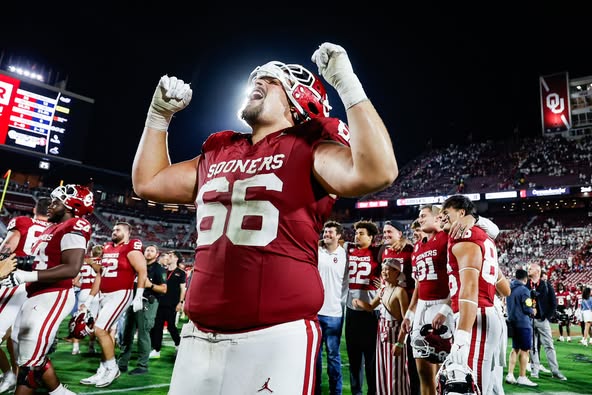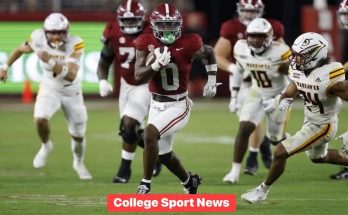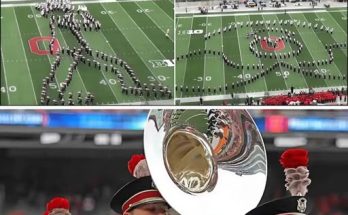On Saturday in Norman, the Oklahoma Sooners secured a pivotal 24–13 victory over the Michigan Wolverines, a result that immediately captured the attention of college football fans and analysts alike. The game, held at the iconic Gaylord Family Oklahoma Memorial Stadium, showcased a mix of strategic brilliance, individual talent, and timely execution, allowing the Sooners to emerge as the victors in a matchup that many had anticipated to be fiercely competitive. From the opening kickoff, both teams demonstrated their intentions to control the tempo, with Michigan attempting to establish dominance through a balanced offensive approach, while Oklahoma relied on its trademark high-powered passing attack to seize early momentum.

The Sooners’ victory was anchored by a disciplined and opportunistic performance on both sides of the ball. Offensively, Oklahoma displayed a measured yet aggressive strategy, with quarterback play serving as the linchpin for their success. The Sooners’ quarterback, who has been steadily developing into one of the most reliable signal-callers in the league, executed a series of precise throws that consistently moved the chains and kept Michigan’s defense on its heels. Timing routes, play-action passes, and a keen sense of reading defensive alignments allowed Oklahoma to exploit gaps in the Wolverines’ defensive schemes. Receivers were able to create separation and convert critical third downs, ensuring the Sooners sustained drives and avoided costly turnovers that could have shifted momentum.

Michigan, on the other hand, faced significant challenges in adjusting to Oklahoma’s offensive tempo. The Wolverines, known for their formidable front seven and disciplined secondary, struggled to contain the Sooners’ versatile receiving corps. While Michigan’s quarterback attempted to rally the team with well-timed passes and occasional scrambles, Oklahoma’s defensive unit applied pressure in key moments, forcing hurried throws and limiting explosive plays. The Sooners’ defensive line, characterized by both speed and strength, disrupted Michigan’s backfield rhythm, preventing the Wolverines from establishing a consistent ground game and compelling them to rely more heavily on passing, which was effectively countered by Oklahoma’s coverage schemes.

Special teams also played a notable role in shaping the flow of the game. Field position battles were crucial, and Oklahoma capitalized on a few well-executed punts and kickoff returns to maintain advantageous positioning throughout the contest. Michigan had moments of promise in the return game, but key penalties and missed opportunities hindered their ability to flip the field consistently. These subtle but critical aspects of the game underscored the importance of execution in all three phases, illustrating that victories in high-level college football often hinge on more than just raw talent or flashy plays.

One of the defining narratives of the game was the performance of Oklahoma’s running game. While the Sooners have often been associated with a pass-first identity, their running back corps delivered in crucial situations, providing balance and preventing Michigan from focusing solely on pass defense. Short-yardage gains, screens, and well-timed sweeps contributed to sustaining drives, controlling the clock, and keeping the Wolverines’ defensive front off balance. The ability to mix in effective rushing plays at key junctures showcased the Sooners’ versatility and depth, which proved instrumental in converting third downs and maintaining possession during high-pressure sequences.

Michigan’s attempts to mount a comeback were met with strategic resilience from Oklahoma’s coaching staff. Adjustments at halftime demonstrated an understanding of situational football, as the Sooners anticipated and countered potential changes in Michigan’s offensive play-calling. Defensive substitutions, zone coverage adjustments, and calculated blitzes prevented the Wolverines from stringing together sustained drives in the second half. Meanwhile, Oklahoma’s offense continued to manage the clock effectively, minimizing the time available for Michigan to orchestrate a late-game rally. This combination of tactical discipline and situational awareness exemplified why coaching decisions are often as critical as individual athletic performances in determining outcomes at this level.

Individual performances stood out as pivotal to the game’s outcome. Several Oklahoma players executed game-changing plays that shifted momentum at crucial moments. Breakaway receptions, timely tackles, and defensive turnovers highlighted the importance of preparation, focus, and seizing opportunities when they arose. For Michigan, despite the defeat, there were flashes of brilliance that demonstrated the team’s potential and competitive spirit. Certain players showcased exceptional athleticism and decision-making under pressure, indicating that while the scoreboard favored Oklahoma, the Wolverines’ efforts were not without merit.
The psychological dimension of the game was equally significant. Playing in front of a home crowd energized Oklahoma, as the stadium’s atmosphere amplified the intensity of each play. Michigan, confronted with the challenge of performing



